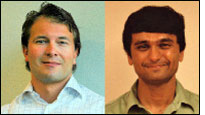Oct 01, 2010In the past few years, there has been a lot of research and commercial development of sensor-equipped RFID tags, in particular, to monitor the shipping and handling of perishable foods and pharmaceuticals. The tags that have emerged typically range in price from $10 to $100 each. At the Auto-ID Lab at the Massachusetts Institute of Technology (MIT), our goal is to develop a sensor tag that costs no more than a basic passive tag—inexpensive enough to be placed, for example, on individual milk cartons to monitor temperature violations or in great numbers on concrete slabs to detect cracks.
Our approach is to create a kind of "alarm" sensor, using a passive EPC Gen 2 ultrahigh-frequency tag and employing its antenna as a sensing mechanism. It is a well-known fact that RFID performance tends to degrade in close proximity to metals and water. We turn this shortcoming into an advantage by having a critical change in a physical parameter, such as temperature or strain, trigger a change in the position of a piece of metal or in the state of a dielectric in close proximity to the tag's antenna.
This critical change in the parameter of interest manifests itself in an altered RFID tag signal response, which, in turn, is picked up by the RFID reader. The changes to the antenna's immediate surroundings can be made permanent—even when the tag is not in range of an RFID reader. This means that a critical change in a physical parameter, such as a temperature violation, can be recorded for detection the next time the tag comes within range of a reader.
This alarm-style sensor could be deployed, for example, at the item, case or pallet level in cold-chain operations to answer the critical question of whether the product was ever subjected to unacceptable temperatures, drastically improving visibility and facilitating better quality control. We are currently exploring partnerships with cold-chain suppliers for pilot testing with fresh produce.
While our technology could make it much more affordable to track products with sensor-equipped RFID tags, it is important to understand that this technology is not a solution for all deployments that could benefit from sensor monitoring. What we gain in cost and ubiquity, we lose in real-time updates and lack of time history of data.
Our paradigm of "tag antenna-based sensing" is ideal for applications that would benefit from the pervasive deployment of low-cost sensors where the question of if a state was violated is more important than when. We are researching the use of tag antenna-based sensing to monitor other applications, in addition to temperature sensing, including strain in infrastructure asset management, wide-area pest control and fluid levels.
Christian Floerkemeier is associate director of the Auto-ID Lab at the Massachusetts Institute of Technology in Cambridge. Rahul Bhattacharyya is a doctorate candidate in civil and environmental systems engineering at MIT.

